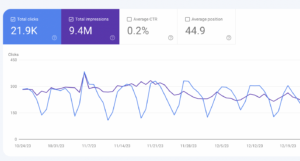Are you a business owner seeking to maximize the potential of your website? Optimization is crucial for businesses, regardless of size or scope, be it a small local venture or a large global corporation. It entails improving your website’s performance and enhancing its efficacy in terms of generating traffic, leads, and conversions.
This comprehensive guide will expertly navigate you through the essential steps of website optimization, empowering you to obtain the most value from your online presence.
What is Website Optimization?
Website optimization carried out through search engine optimization (SEO), involves ensuring that your website fulfills all the criteria needed to achieve top rankings in search engine results.
Various factors contribute to your website’s visibility, such as content quality, strategic keyword usage, backlinks, and page speed. The objective is to enhance the discoverability by potential customers when they search for relevant terms online. Through SEO, you can elevate the overall performance of your website and significantly increase its chances of achieving its goals.
Why is Website Optimization Important?
Optimizing your website isn’t just important — it’s essential! A well-optimized site will help you reach more potential customers, as it’ll appear higher up in the search engine results pages (SERPs).
This means that people searching for related terms will be more likely to find your site and click on it. Additionally, a well-optimized website is also much easier to navigate and use, which can result in better user experience and potentially more conversions.
Optimization is an ongoing process requiring continuous learning and adaptation to industry trends and user feedback. Staying updated with the latest SEO best practices and algorithm changes is essential to maintain a competitive edge.
What Happens if I Don’t Optimize My Website?
If you don’t optimize your website, you’ll miss out on valuable traffic and leads that could have been generated from appearing higher up in the search results. Additionally, if your website is slow or difficult to use, people may not bother staying long enough to explore your content or convert.
What Are Core Web Vitals?
Core Web Vitals are a set of specific metrics that measure the performance and user experience of a website. These metrics are designed to assess key aspects of web page loading, interactivity, and visual stability. Core Web Vitals provide website owners and developers with standardized benchmarks for evaluating and improving their sites’ performance.
There are three main metrics that make up Core Web Vitals:
- Largest Contentful Paint (LCP): This metric measures the time it takes for the largest content element, such as an image or a block of text, to become visible to the user. It helps determine how quickly the main content of a page loads.
- First Input Delay (FID): FID measures the time it takes for a web page to respond to a user’s first interaction, such as clicking a button or tapping on a link. It assesses the responsiveness and interactivity of a website.
- Cumulative Layout Shift (CLS): CLS measures the visual stability of a web page by quantifying the amount of unexpected layout shifts that occur during the page’s loading process. Layout shifts can be frustrating for users, especially if they accidentally click on a different element due to a sudden shift.
Google introduced Core Web Vitals as part of its initiative to improve the overall user experience on the web. These metrics are now considered important factors in determining a website’s ranking in search engine results, as Google aims to prioritize sites that provide a better user experience.
By optimizing websites based on Core Web Vitals, business owners can enhance page performance, increase user satisfaction, and potentially improve their sites’ search engine visibility.
How to Optimize Your Website
Site optimization plays a crucial role in improving Core Web Vitals and overall website performance. By optimizing your website, you can enhance user experience, increase page loading speed, and reduce layout shifts, all of which contribute to better Core Web Vitals scores. Here are the most important steps you’ll need to take:
On-Page Optimization
One crucial aspect of website optimization is your on-page strategy, which involves optimizing individual web pages to rank higher and attract relevant traffic. To master on-page optimization, you should pay attention to elements such as keyword research, meta tags, headings, and content.
Site Speed Optimization
Site speed is a critical factor that impacts both user experience and search engine rankings. Slow-loading websites can frustrate visitors and lead to higher bounce rates. Make sure the most important content on your web page, referred to as “above-the-fold” content, loads quickly. This includes text, images, and interactive elements that users see immediately without scrolling. To optimize your speed, compress images, enable browser caching, minify CSS and JavaScript files, and leverage content delivery networks (CDNs).
Mobile Optimization
With the majority of internet users accessing websites through mobile devices, optimizing your website for mobile is essential. Responsive design, which ensures that your website adapts to different screen sizes, is a must-have. Additionally, consider minimizing the use of pop-ups, using legible fonts, and optimizing your images for mobile devices.
Backlink Building
Backlinks, also known as inbound links, are links from external websites that direct users to your site. Building high-quality backlinks is crucial for improving your website’s authority and organic search engine rankings. Focus on obtaining backlinks from reputable websites in your industry through strategies such as guest blogging, content promotion, and influencer outreach.
User Experience Optimization
User experience (UX) optimization plays a vital role in keeping visitors engaged and converting them into customers. Start by ensuring your website has a clear and intuitive navigation structure, clean design, and easy-to-read content.
Content Optimization
Content is still king when it comes to website optimization. Create high-quality, relevant, and engaging content that resonates with your target audience. Incorporate relevant keywords strategically throughout your content and make use of headers, bullet points, and images to enhance readability.
Analyzing and Monitoring
Optimization is an ongoing process, and it’s crucial to analyze and monitor the performance of your website regularly. Utilize tools like Google Analytics to track key metrics such as traffic, bounce rate, conversions, and keyword rankings. Use these insights to identify areas for improvement and adjust your optimization strategies accordingly.
Are Images Vital to Website Optimization?
Yes, images play an important role in website optimization. Good-quality pictures can make a website look more professional and visually appealing, which helps to create a better user experience that can result in higher conversions.
Additionally, all images should be properly named (including relevant keywords) and compressed for faster loading times. Don’t forget to add the ALT tag — this is what search engine crawlers read to understand what the image is about. ALT tags also provide invaluable information for screen-reader users who are visually impaired.
- Properly name images with relevant keywords
- Compress images for faster loading times
- Add ALT tags to all images
Website Optimization Checklist
Business owners that are new to website optimization may find the process challenging. Here’s a checklist of steps you can take to make sure your site is optimized:
- Perform keyword research and choose relevant search terms for each page on your website.
- Optimize your meta tags with content that matches user search intent.
- Structure all the pages on your website to ensure easy navigation and maximize SEO value.
- Employ internal links between related content.
- Utilize best practices for fast-loading pages.
- Build authority by getting high-quality backlinks.
- Make sure all aspects display properly on mobile devices.
- Test and analyze individual elements of your website using platforms like Google Experiments & Visual Website Optimizer, plus “heatmap tracking” tools like Hotjar to make sure visitors can easily interact with them.
By ticking off each item in this checklist, you’ll be well on your way to optimizing your website and attracting more organic traffic!
Website Optimization KPIs
The key performance indicators (KPIs) to watch out for during and after the optimization process include:
- Page Load Speed: This metric measures the time it takes for a web page to fully load. A faster page load time improves user experience and can positively impact engagement and conversion rates.
- Bounce Rate: Bounce rate refers to the percentage of visitors who leave your website after viewing only one page or piece of content. A high bounce rate may indicate issues with page relevance, usability, or performance. Lowering the bounce rate is often a goal of website optimization.
- Conversion Rate: Conversion rate measures the percentage of website visitors who complete a desired action, such as making a purchase, filling out a form, or subscribing to a newsletter. Optimizing your website can help improve conversion rates and drive business objectives.
- Average Session Duration: This metric tracks the average time visitors spend on your website during a session. Longer session durations indicate higher engagement and interest in your content.
- Exit Pages: Analyzing exit pages shows which pages visitors frequently leave your website from. Understanding why users are leaving can help identify areas that need improvement and optimize those pages to encourage further engagement.
- Click-Through Rate (CTR): CTR measures the percentage of users who click on a specific element, such as a call-to-action button or a link. It is often used to evaluate the effectiveness of content placement and design elements for SEO performance.
- Mobile Performance: This can include metrics such as mobile page load time, mobile bounce rate, and mobile conversion rate.
- Search Engine Rankings: While not directly related to website optimization, tracking your website’s rankings on search engine result pages (SERPs) can indicate the effectiveness of your optimization efforts over time.
- Core Web Vitals: As mentioned earlier, Core Web Vitals metrics, including Largest Contentful Paint (LCP), First Input Delay (FID), and Cumulative Layout Shift (CLS), provide specific measurements of your website’s performance and user experience. Monitoring and improving these metrics can lead to better overall website optimization.
More Website Optimization Tips
- Utilize structured data to make sure search engine crawlers can easily understand the content on your website and properly index it. Structured data can also be used to create rich snippets in search engine results pages, which provide more information about your website and result in higher click-through rates.
- Create an XML sitemap and submit it to search engines so they can quickly find all the pages on your website. This will help them better understand the structure of your website as well as how often each page is updated.
- Take advantage of social media platforms by creating content that targets a specific audience and promoting it across multiple channels. Doing this will increase brand awareness, drive more traffic to your website, and create opportunities for link building with influencers in the industry.
- Optimize URLs by ensuring they are short, descriptive, and contain relevant keywords so users know what to expect before clicking on a link.
- Implement analytics and SEO tools such as Google Analytics or Ahrefs so you can track user behavior and identify any problems that need to be addressed on your website. Doing this will help you measure progress toward goals and make improvements accordingly.
The Bottom Line
Website optimization is an essential step for any business that wants to succeed. It not only helps to improve user experience but can also help you rank higher in SERPs and convert more visitors into customers.
Markitors is a trusted digital marketing partner that can help with website optimization. Through our unique combination of strategies and services, we are able to help businesses achieve success online.
Our team specializes in helping small business owners get their websites optimized for search engine algorithms, as well as increasing visibility through SEO, content marketing, digital PR, and technical SEO.
Contact the Markitors team today to learn more, or dive right in with a free SEO audit.







